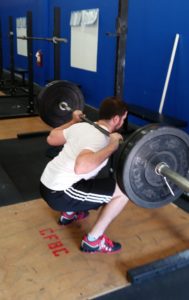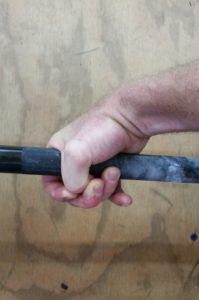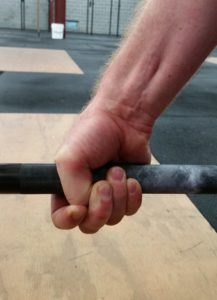
Anyone with little weightlifting experience can manage to coach the Clean and maybe the Jerk; however, it requires true bio-mechanical understanding, coaching experience, planning, and clear communication to teach and coach the Snatch. As with the Clean and Jerk, coaches use the Snatch to help the athlete develop explosive power, mobile strength, and precise motor control of large muscle groups. While many coaches can help an athlete develop strength and motor control, the main under addressed topic is mobility (the product of flexibility and stability). This tends to be ignored, as athletes have under developed mobility when it comes to a perfect setup. Setup can vary slightly from one athlete to another, however, there are general rules that always apply.
According to Lifetime Athletic’s Alpha Training Manual and NSCA’s Essentials of Strength training and Conditioning we have general tips to follow:
- Arm measurement: fist to opposite shoulder, or elbow to elbow; thus allowing the bar to set at hip crease when finishing 1st
- Grip width is wider than any barbell exercise as mentioned above
- Feet planted closer than hip width and toes pointed forward
- Pinch shoulder blades together
- Brace up core (football ready position)
- Squat down like in a straight line so that knees are slightly beyond bar (top shoe lace in line with bar), and shoulders above bar
- Hips are lower than shoulders at all times
- Back is flat and straight like a steel rod
As snatch is a power movement that involves great motor control, mobility is our base. If the available range of motion (ROM) during active movement is not ideal, a coach is advised to break the exercise into mainly four parts: 1- The Overhead Squat, 2- The Snatch Deadlift, 3- The Snatch Pull, 4- The Muscle Snatch.

Good deep back squat position

Bad Hook Grip

Good Hook Grip
Common Mobility issues can occur from different factors; in guys mainly in lack of flexibility, and in ladies in lack of stability. Some of these mobility issues are:
- Weak grip on bar, and weak arm reach (also can cause flat back but bent arms). Usually for weak grip on the bar the athlete needs to train hook grip and understand that arms should be loose like ropes, but hands strong as hooks. Weak arm reach can be due to many factors, but mainly in males is due to tight pectoral and latissimus dorsi muscles.
- Not deep enough squat (high hips closer or more than shoulders). This major issues stems typically from the athlete lacking a proper deep squat position; inflexible quadriceps, hamstrings, glutes and weak limbo pelvic hip control. These muscles must be trained enough in strength and flexibility movements enough to get hips to the proper depth height, AND strong enough to maintain that position statically (as Erin mentioned in the clean setup). Both static (after lifting) and dynamic stretching (before lifting) can help with this issue. My favorite is trying to get the athlete to always warmup with an overhead squat using a PVC pipe or a dowel (usually 3 sets of 5 reps). Dynamic warm ups, such as hip mobility for hips, mini band warmups for glutes, and yogi squat for hamstrings and quads will do a huge part in helping the athlete achieve a deeper squat.
- Rounded back. A strength coach’s most common recurring issue with athletes. In the case of the snatch this can be a number of factors:
- Bending over to pick the bar instead of squatting down. Inform the athlete they need to lower their glutes like an elevator in a straight line vs an escalator in diagonal line.
- Immobile pectoral and shoulder muscles: more common with male athletes who perform too much pushing exercises vs pulling. Easy fix are the watch the volume of pushing (and form) exercises, and use a lot of PVC pipe shoulder pass through and PVC around the world before starting the lift; moreover, using chest, lat, and shoulder stretching after the lift.
- Setting at a depth where the glutes round under an athlete. Sitting too low at the setup can ruin the less than ideal force production as there is not enough length to create power ((force x distance)/ time). Stretching in issue number 2 and in number 3 should tremendously fix this error.
A successful snatch starts in a successful position as with any lift. It is imperative to not only be able to maintain a proper starting position, but also to move efficiently, time the 1st pull slowly off the floor, and 2nd pull near hip crease, and powerfully triple extend from that position. Breaking down the elements and positions of a Snatch is vital to safely progressing a lift that requires an impeccable starting position; a starting position that could be greatly enhanced by avoiding the many issues that arise from the lack of mobility and experience.
Baechle, Thomas R, Earle Roger W. “Power Exercises.” Essentials of Strength Training and Conditioning. 3th ed. N.p.: National Strength and Conditioning Association, 2012. 374-375. Print.
Lifetime Athletic Alpha Training manual, “Olympic lifts” page 85-92
Amer Nahhas CSCS, NSCA-CPT, USAW-L1
“The views, opinions, and judgments expressed in this message are solely those of the authors and peer reviewers. This content has been reviewed by a team of contributors but not approved by any other outside entity including the Roman Catholic Diocese of Raleigh.”

